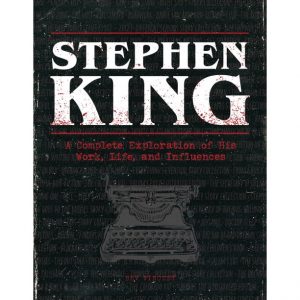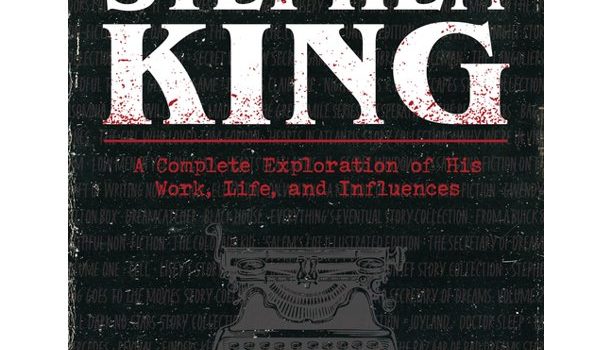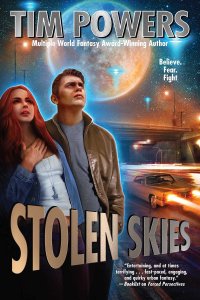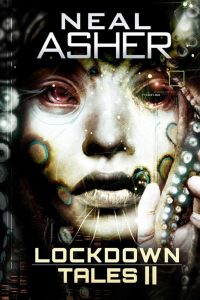Alvaro Zinos-Amaro Reviews Stephen King: A Complete Exploration of His Work, Life and Influences by Bev Vincent
 Stephen King: A Complete Exploration of His Work, Life and Influences, Bev Vincent (becker&mayer! books 978-0760376812, $30.00, 240pp, hc) September 2022.
Stephen King: A Complete Exploration of His Work, Life and Influences, Bev Vincent (becker&mayer! books 978-0760376812, $30.00, 240pp, hc) September 2022.
In “After the Accident (2000s)”, the fifth and penultimate chapter of The Stephen King Ultimate Companion: A Complete Exploration of His Work, Life, and Influences, a profusely illustrated biographical guide to King’s life and career, Bev Vincent writes: “Characters suffering grievous physical injuries began to appear regularly in his books and stories, and the fact that he wrote frequently about pain – which he called the little green God of agony in one story – reveals much about what he was enduring during this decade and beyond.” The observation contextualizes the books that follow, but it’s that almost throwaway detail about King calling pain “the little green God of agony” that proves more telling; it’s representative of Vincent’s intimate knowledge of his subject’s enormous body of work, and also exemplifies the lightness with which he wears that learning. Throughout the course of this chapter, the four preceding ones – “The Future Artist As a Young Man (1950-1969)”, “The Doubleday Years (1970s)”, “Midas Touch (1980s)”, “Experimentation and Change (1990s)” – and the book’s concluding installment, “King of Crime (2010 and beyond)”, Vincent consistently displays that same knack for expertly tucked-away nuggets amidst a more conventional narrative paved on book publications and career milestones. Vincent writes about King in a direct and simple style that allows King, often quoted verbatim, to rise to the fore. The volume, “published on the occasion of Stephen King’s seventy-fifth birthday,” transcends the simple marketing tool or hagiographic indulgence it might have been by combining studious knowledge with accessibility and insight. As Vincent points out, “no one else symbolizes an entire genre the way King does,” and this concise but nevertheless comprehensive overview provides an argument as to how King may have ended up in such a unique position.
Mining a treasure-trove of “personal ephemera” Vincent’s account begins with King’s family history, notes that King “started to write stories at the age of six,” and amusingly details King’s first experience with “bestsellerdom” in 1961, when King wrote a 12-page novelization of Roger Corman’s Poe film adaptation The Pit and the Pendulum and sold “something like seventy” copies at a dime each to his schoolmates (he was eventually made to return the money). Things move briskly as King pursues his passion for storytelling, begins submitting short stories for publication in his early teens, and finds freedom of expression and the beginnings of a voice writing for small, mostly local outfits. Many of the beats that follow will be familiar to followers of King’s own autobiographical pieces, such as On Writing, or readers of Lisa Rogak’s biography Haunted Heart: The Life and Times of Stephen King (2009), but in addition to the plethora of photographs, manuscript sample pages, and cover art, Vincent authors numerous “Interludes” that differentiate this book from the aforementioned and whet the appetite for more. These asides cover diverse topics such as King’s poetry, King’s relationship with editor Bill Thompson, the collectability of certain editions (“only five copies… are known to exist,” for example, of a specific cover variant of ’Salem’s Lot), King’s work as Richard Bachman, the accident that nearly killed him, and King as a sports fan and sportswriter. As we proceed bestseller by bestseller and decade by decade, patterns emerge regarding King’s writing process. Almost invariably striking images initiate novel ideas; singular scenes grow, through tenacious writing and re-writing, into thousand-page manuscripts, with King thriving on the process of simultaneous creation and discovery. Novels like Insomnia and Rose Madder are deemed inferior to their brethren by King because they were “plotted novels,” their stories predetermined. By contrast, King “reveled in the danger of the approach” to the serialized The Green Mile, for which he hadn’t written the last installment when the first one hit bookstores. Ideas can gestate for years, even decades (e.g. Under the Dome), while others are pursued breathlessly, depending on whether King feels that he’s ready to do them justice on a technical level. Vincent gives voice to some of King’s critics, as for instance in a sidebar wherein Harold Bloom opines that King is “an immensely inadequate writer.” (King’s candid retort can be found on the following page). While Vincent’s plot synopses, commentaries, and King’s interview excerpts make it clear that King sees himself in the service of popular culture, they also highlight the seriousness with which he approaches his vocation (e.g. visiting locations for research purposes, or engaging subject matter experts, like Doris Kearns Goodwin and Dick Goodwin, for example, while working on 11/22/63). Underlying all this is an unyielding discipline, a compulsion to compose married to the belief that writing affords almost mystical solace for both psychological and physical woes, a philosophy that likewise seems to animate King’s near coeval, the similarly wildly prolific Joyce Carol Oates. Vincent shows how time and again King has bolstered his outreach by experimenting with new story-delivery methods and technologies, and that he isn’t above the pragmatism of running reader polls on his website to help decide which book to write next or simply gauge fan interest in particular projects (e.g. The Shining’s long-belated sequel Doctor Sleep). The volume is rounded out by three helpful appendices covering Books, Short Stories and Novellas, and Adaptations.
In the The Modern Myths, Philip Ball offers his candidacy criteria for those rare texts that might serve as cultural ur-narratives for decades to come. Through a career spanning 50 years, some 70 novels, a dozen short story collections, a handful of non-fiction books, and countless screenplays and ancillary projects, I’d place a firm wager on King having unleashed at least one such contender for future myth. Is it The Shining? Maybe The Stand? How about the multi-volume Dark Tower? Something more horrifically kaleidoscopic, like It, or perhaps more slippery, like Lisey’s Story, which in the world of Boo’ya Moon contains its own fictive “myth pool” from which artists draw direct inspiration? “The way I’m built is to try and give people pleasure,” King says at the end of our companionable journey, and that’s a book from which Vincent has, with this informative and entertaining celebration, taken more than a page.
Alvaro Zinos-Amaro, Roundtable Editor, is co-author of a book of interviews with Robert Silverberg, Traveler of Worlds, that was a Hugo and Locus Award finalist in 2017. Alvaro’s more than 30 stories and 100 reviews, essays and interviews have appeared in magazines like Clarkesworld, Asimov’s, Apex, Analog, Lightspeed, Nature, Strange Horizons, Beneath Ceaseless Skies, Galaxy’s Edge, Lackington’s, and anthologies such as The Year’s Best Science Fiction & Fantasy 2016, Cyber World, Humanity 2.0, and This Way to the End Times.
This review and more like it in the October 2022 issue of Locus.
 While you are here, please take a moment to support Locus with a one-time or recurring donation. We rely on reader donations to keep the magazine and site going, and would like to keep the site paywall free, but WE NEED YOUR FINANCIAL SUPPORT to continue quality coverage of the science fiction and fantasy field.
While you are here, please take a moment to support Locus with a one-time or recurring donation. We rely on reader donations to keep the magazine and site going, and would like to keep the site paywall free, but WE NEED YOUR FINANCIAL SUPPORT to continue quality coverage of the science fiction and fantasy field.
©Locus Magazine. Copyrighted material may not be republished without permission of LSFF.








